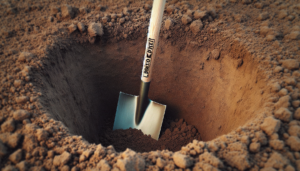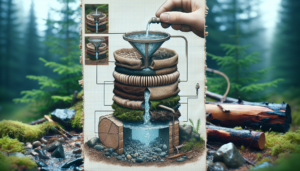
In today’s modern world, where convenience and technology have provided us with many tools to make our lives easier, it may seem unnecessary to know how to start a fire without matches or a lighter. However, there are instances where this knowledge can be both practical, such as in outdoor survival situations, or simply an interesting skill to possess. This article will explore a few techniques and methods that you can employ to start a fire without traditional fire-starting tools, relying instead on nature’s resources and your own resourcefulness.
Friction-based methods
Bow drill method
The bow drill method is one of the most effective friction-based methods for starting a fire. To use this method, you will need a bow, a drill, a fireboard, and some tinder. The bow is typically made from a curved stick with a string tied to each end. The drill is a straight stick that is placed on the fireboard. By rotating the bow back and forth, the drill spins rapidly against the fireboard, creating friction and generating heat. This heat eventually ignites the tinder, starting a fire.
Hand drill method
The hand drill method is similar to the bow drill method, but instead of using a bow, you will use your hands to create the friction. This method requires a lot of practice and hand strength. You will need a straight stick as the drill and a fireboard. To start a fire using the hand drill method, you will place one end of the drill on the fireboard and use your hands to rotate the drill rapidly, applying downward pressure. The friction generated by the spinning creates heat, eventually igniting the tinder.
Fire plow method
The fire plow method involves using a long, flat piece of wood called a plow and a baseboard with a groove. You will rub the plow back and forth in the groove of the baseboard, generating friction and heat. The heat produced by the friction ignites the tinder, starting a fire. This method requires a good amount of strength and endurance, as it can be physically demanding.
Fire saw method
The fire saw method is another friction-based technique that can be used to start a fire without matches or a lighter. This method requires a saw-like device called a fire saw, which consists of a straight, flat piece of wood with a notch cut into it. You will need to place a piece of tinder in the notch and then rapidly saw back and forth, creating friction and heat. The heat generated by the sawing action ignites the tinder, starting a fire.
Lens-based methods
Using eyeglasses
If you have a pair of eyeglasses with a convex lens, you can use them to start a fire. The key is to angle the lenses so that the sunlight passing through them converges onto a single point. Place a piece of tinder at this focal point and adjust the angle of the lenses until the tinder begins to smolder and catch fire. This method requires clear skies and direct sunlight.
Using a magnifying glass
A magnifying glass with a convex lens can also be used to start a fire. Similar to using eyeglasses, you will need to angle the magnifying glass so that the sunlight passing through it converges onto a single point. Place a piece of tinder at this focal point and adjust the angle of the magnifying glass until the tinder begins to smolder and ignite. Again, clear skies and direct sunlight are necessary for this method to work effectively.
Using a glass bottle filled with water
A glass bottle filled with water can act as a makeshift lens to start a fire. Fill the glass bottle with water and use it to focus sunlight onto a piece of tinder. Angle the bottle so that the sunlight passing through the water converges onto a single point. Adjust the angle until the tinder begins to smolder and catch fire. This method can be especially useful in survival situations where you may not have access to traditional fire-starting tools.
Chemical reactions
Potassium permanganate and glycerin
Potassium permanganate and glycerin can be combined to create a chemical reaction that results in fire. First, create a small pile of potassium permanganate powder. Using a dropper or a small syringe, carefully add a few drops of glycerin to the potassium permanganate pile. The glycerin will react with the potassium permanganate, generating enough heat to ignite the surrounding material, such as paper or dried leaves. This method should be handled with care, as both potassium permanganate and glycerin can be hazardous.
Pencil lead and AA battery
A pencil lead and an AA battery can be used to create a spark that can ignite a fire. Break off a small piece of pencil lead and attach one end to the negative terminal (the flat end) of an AA battery. Hold the other end of the pencil lead against the positive terminal (the raised end) of the battery. The electrical current passing through the pencil lead will create a spark that can be used to ignite a piece of tinder. This method is convenient as it requires common household items.
Sodium and water
Sodium and water can create a chemical reaction that results in fire. However, it is important to note that this method is highly dangerous and should only be attempted by professionals in a controlled environment. When sodium comes into contact with water, it reacts violently, releasing hydrogen gas and heat. This reaction can lead to a fire or even an explosion. Sodium should never be used as a means to start a fire unless proper precautions and safety measures are in place.
Electrical methods
Car battery and steel wool
A car battery and steel wool can be used to start a fire. By touching a piece of steel wool to both terminals of a car battery, an electrical current passes through the steel wool, generating heat. The heat causes the steel wool to ignite, creating sparks that can be used to ignite tinder. It is important to exercise caution when using this method, as car batteries can produce a significant amount of heat and sparks.
9-volt battery and gum wrapper
A 9-volt battery and a gum wrapper can be used to create a spark that can start a fire. First, tear the gum wrapper into a thin strip and hold each end of the strip against the positive and negative terminals of the 9-volt battery. The electrical current passing through the gum wrapper will cause it to heat up, eventually igniting and producing a spark. This spark can be used to ignite a piece of tinder, starting a fire. It is important to handle the battery and gum wrapper with care to avoid accidental shocks or burns.
Sparking rocks together
Certain types of rocks, such as flint or quartz, can be used to create sparks by striking them together forcefully. The sparks generated by these rocks can ignite a piece of tinder, starting a fire. To use this method, hold one rock in your hand and strike it against another rock, directing the sparks onto the tinder. This method requires practice and can be more challenging than other fire-starting methods, but it is a reliable option when matches or lighters are not available.
Sunlight-based methods
Using a solar lighter
A solar lighter is a small device that uses the sun’s energy to focus light onto a single point, creating enough heat to ignite a fire. To use a solar lighter, simply open the device and position it so that the sunlight passing through the lens is focused onto a piece of tinder. Adjust the angle or position of the solar lighter until the tinder begins to smolder and catch fire. This method is convenient and reliable, as it does not require any additional tools or materials.
Creating a magnifying effect with ice
In a survival situation where matches or lighters are not available, you can create a makeshift magnifying glass using ice. Find a block of ice or shape some ice into a lens-like shape. By carefully angling the ice block or lens so that the sunlight passing through it converges onto a single point, you can focus the light and generate enough heat to ignite a piece of tinder. This method requires clear skies and direct sunlight, as well as some resourcefulness in creating the ice lens.
Chemical fire starters
Potassium permanganate and sugar
Potassium permanganate and sugar can be combined to create a chemical reaction that starts a fire. Mix equal parts of potassium permanganate and sugar together and then ignite the mixture using a flame or spark. The mixture will begin to burn rapidly, emitting heat and sparks. This method can be useful in emergency situations where traditional fire-starting tools are not available, but it should be used with caution, as the reaction can be quite intense.
Sulfur and zinc dust
Mixing sulfur and zinc dust together can create a powerful chemical reaction that generates enough heat and sparks to ignite a fire. Simply combine the two substances, and then ignite them using a flame or spark. The reaction will produce heat and sparks, allowing you to ignite a piece of tinder and start a fire. However, it is important to note that both sulfur and zinc dust can be hazardous, so this method should be handled with caution and in a well-ventilated area.
Sparking tools
Flint and steel
Using flint and steel is a traditional method of starting a fire without matches or a lighter. By striking a piece of steel against a flint rock, sparks are created. Direct these sparks onto a piece of tinder, such as char cloth or a nest of dry grass, to ignite it and start a fire. This method requires practice to master, as the angle and force of the strike are crucial in generating sparks. Flint and steel are reliable fire-starting tools that can be used in various weather conditions.
Ferrocerium rod
A ferrocerium rod, also known as a firesteel or a flint rod, is a popular tool for starting fires in outdoor and survival situations. By scraping a metal object, such as a knife or a striker, against the ferrocerium rod, sparks are created. Aim these sparks onto a piece of tinder to ignite it and start a fire. Ferrocerium rods are lightweight, durable, and can produce a high volume of sparks, making them an excellent fire-starting tool in various conditions.
Fire piston
A fire piston is a device that uses rapid compression of air to create heat and ignite tinder. The fire piston consists of a cylindrical tube with a piston inside. To use a fire piston, insert a small piece of tinder, such as char cloth, into the end of the tube. Rapidly push the piston into the tube, compressing the air inside. The compression generates heat, igniting the tinder and starting a fire. Fire pistons require some practice to master, but once mastered, they can be a reliable fire-starting tool.
Natural materials
Focusing sunlight using a parabolic mirror made from natural materials
A parabolic mirror made from natural materials, such as wood or coconut shells, can be used to focus sunlight onto a piece of tinder, igniting it and starting a fire. By carving or shaping the natural material into a concave shape with a reflective inner surface, sunlight can be concentrated onto a single point. Position the tinder at this focal point and adjust the angle or position of the mirror until the tinder begins to smolder and ignite. This method combines resourcefulness and natural materials to start a fire.
Using char cloth and a traditional fire-making method
Char cloth is a material that has been carbonized through a slow-burning process. It can be used in conjunction with various traditional fire-making methods, such as the flint and steel method or the bow drill method. By directing sparks or friction onto a piece of char cloth, it quickly catches fire and ignites a tinder bundle, starting a fire. Char cloth is lightweight, easy to carry, and can be made from natural materials like cotton. It is a reliable fire starter that can be used in challenging conditions.
Alternative fire starters
Alcohol-based hand sanitizers
Alcohol-based hand sanitizers can be used as an alternative fire starter when matches or lighters are not available. The high alcohol content in hand sanitizers makes them highly flammable. To use hand sanitizer as a fire starter, squeeze a small amount onto a piece of tinder, such as dry leaves or paper, and ignite it using a spark or flame. It is important to exercise caution when handling open flames and alcohol-based products.
Steel wool and batteries
Steel wool and batteries can be used to start a fire by creating an electrical current that generates heat. Simply touch the positive and negative terminals of a battery to a piece of steel wool. The electrical current passing through the steel wool will cause it to heat up and produce sparks, which can ignite a piece of tinder. This method is convenient and relatively straightforward, as it requires common household items.
Safety measures
Outdoor location and fire regulations
When starting a fire outdoors, it is essential to consider the location and any fire regulations or restrictions that may be in place. Ensure that you are in a safe and authorized area where fires are permitted. Familiarize yourself with any local or regional regulations regarding fire usage, such as obtaining permits or adhering to specific rules. By following these guidelines, you can ensure both your safety and the preservation of the environment.
Clearing a safe area
Before starting a fire, it is important to clear a safe area to prevent the fire from spreading uncontrollably. Remove any flammable materials, such as dry leaves, grass, or debris, from the immediate vicinity of the fire. Create a clear space around the fire pit to minimize the risk of accidental fires. Additionally, ensure that there are no low-hanging branches or overhead obstacles that could catch fire. By taking these precautions, you can minimize the risk of the fire spreading beyond your control.
Having fire extinguishing materials nearby
Regardless of the fire-starting method you choose, it is crucial to have fire extinguishing materials nearby. Keep a bucket of water, sand, or dry chemical fire extinguisher readily available in case of emergencies. These materials can help you quickly and effectively extinguish a fire that becomes unmanageable or poses a safety risk. It is better to be prepared and ensure your safety than to risk the fire getting out of control.
In conclusion, there are several methods to start a fire without matches or a lighter. Friction-based methods like the bow drill, hand drill, fire plow, and fire saw require physical effort and practice. Lens-based methods use the power of sunlight and a magnifying effect to ignite tinder. Chemical reactions involving substances like potassium permanganate, glycerin, or pencil lead and a battery can also start fires. Electrical methods using batteries or sparking rocks together generate sparks to ignite tinder. Sunlight-based methods include using a solar lighter or creating a magnifying effect with ice. Chemical fire starters involve mixing specific substances to create a reaction that results in fire. Sparking tools like flint and steel, ferrocerium rods, or fire pistons require skill and technique. Natural materials like parabolic mirrors or char cloth can focus sunlight or facilitate traditional fire-making methods. Alternative fire starters such as alcohol-based hand sanitizers or steel wool and batteries provide convenient options. Finally, it is crucial to prioritize safety by considering outdoor locations and fire regulations, clearing a safe area, and having fire extinguishing materials nearby. With these methods and safety measures, you can start a fire in various situations, ensuring warmth, cooking, and survival when matches or lighters are not available.






